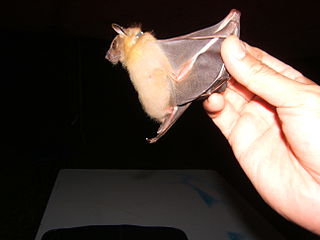
Megabats constitute the family Pteropodidae of the order Chiroptera (bats). They are also called fruit bats, Old World fruit bats, or—especially the genera Acerodon and Pteropus—flying foxes. They are the only member of the superfamily Pteropodoidea, which is one of two superfamilies in the suborder Yinpterochiroptera. Internal divisions of Pteropodidae have varied since subfamilies were first proposed in 1917. From three subfamilies in the 1917 classification, six are now recognized, along with various tribes. As of 2018, 197 species of megabat had been described.

The western tarsier is the only species of tarsier in the genus Cephalopachus. Named by American naturalist Thomas Horsfield, it is also incorrectly referred to as Horsfield's tarsier. The species occurs on Borneo, Sumatra and nearby islands and is, like other members of the group, entirely nocturnal.

Cynopterus is a genus of megabats. The cynopterine section is represented by 11 genera, five of which occur in Malaysia, namely, Chironax, Balionycteris, Penthetor, Dyacopterus, and Cynopterus. About 30 names for Cynopterus species have been proposed, but only 16 are taxonomically valid forms.

The spotted-winged fruit bat is the smallest megabat in the world. It inhabits forests in Brunei, Indonesia, Malaysia, and Thailand.
B. maculata may refer to:
The subfamily Cynopterinae comprises 24 species of pteropodid bats distributed exclusively in South and Southeast Asia.
Elaeocarpus stipularis is a tree in the Elaeocarpaceae family. It is found from the Aru Islands, eastern Indonesia, to Philippines, and through Mainland Southeast Asia to Odisha, India. It has edible fruit, its wood is used and some medical uses are ascribed to it.




